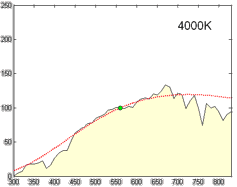Full-spectrum light is light that covers the electromagnetic spectrum from infrared to near-ultraviolet, or all wavelengths that are useful to plant or animal life; in particular, sunlight is considered full spectrum, even though the solar spectral distribution reaching Earth changes with time of day, latitude, and atmospheric conditions.
"Full-spectrum" is not a technical term when applied to an electrical light bulb but rather a marketing term implying that the product emulates natural light.[1]
Products marketed as "full-spectrum" may produce light throughout the entire spectrum, but actually do not produce an even spectral distribution, and may not even differ substantially from lights not marketed as "full-spectrum".[1][2]
Contents
- 1 Measurement
- 2 Use in art and in color matching
- 3 Use in aquariums
- 4 Use in gardening
- 5 Use in seasonal affective disorder
- 5.1 Independent verification
- 6 See also
- 7 References
Measurement
Color temperature and Color Rendering Index (CRI) are the standards for measuring light. There is no technical definition of "full-spectrum" so it cannot be measured. To compare "full-spectrum" sources requires direct comparison of spectral distributions.
A cube of carbon "C" will radiate light of varying spectral power distribution (SPD) as it is heated. At 0 K, it is pure black, while at about 5,000 K to 5,500 K, it appears similar to noon daylight.
Use in art and in color matching
Ideally, during the day, the art studio should be lit with northern sunlight (in the northern hemisphere), because it is considered more neutral and diffused than the direct, "yellowish" quality of southern sunlight.[clarification needed] Since many artists' studios don't have north-facing windows, full-spectrum lamps are sometimes used to approximate such light. Full-spectrum fluorescent lamps are also used by color scientists, color matchers in paint stores and quilters and others working with fabrics or yarn when working under inadequate lighting conditions to assist in achieving the correct hues as they will later appear in daylight or under gallery lighting.
Use in aquariums
Full spectrum lighting is used both for tropical and marine fish as well as many other water pets. The use of full spectrum lighting assists aquarium plants to grow and aids in the health of the fish and the tank as a whole.
Use in gardening
Gardening under lights keeps plants blooming almost year-round, for a wintertime harvest. Grow lights are specifically intended to support plant growth, although with varying degrees of success and energy efficiency. Some plants grow better when given more of a certain color light, due to the mechanism of photosynthesis. Specifically more blue wavelengths enhance vegetative growth and development, while the addition of increasing amounts of red light enhances budding, flowering and fruiting.
Use in seasonal affective disorder
In recent years, full-spectrum lighting has been used in the treatment of seasonal affective disorder (SAD) through the use of "light box" that mimic natural sunlight, which may not be available in some areas during the winter months. Light is an environmental stimulus for regulatingcircadian cycles.
Light box therapy, otherwise known as phototherapy, is a recognized modality for depression (such as SAD). It is also the primary treatment forcircadian rhythm sleep disorders. Depending on the quality of the light, it is estimated that 10,000 lux is needed for effective treatment. Not all light boxes are the same, and some produce only blue or green light.
Independent verification
The non-profit Lighting Research Center, a group of utility companies, experts and government agencies, established the National Lighting Product Information Program (NLPIP) in the USA to provide objective information about the effectiveness of different lighting systems. According to the NLPIP, full-spectrum light does not provide any improved benefits over similar light systems.[3][4]
A Cornell University study reached mixed conclusions on the use of full-spectrum lighting in restaurants to promote sales.[5]
The National Research Council of Canada Institute for Research in Construction, a Canadian government research and development agency, has published several scientific articles about full-spectrum lighting, collected on their web page. The authors of these papers also have concluded that full-spectrum lighting (~5000 K, CRI>90) does not confer any benefits on performance, mood, or health compared to typical cool-white fluorescent lighting.[6][7]

No comments:
Post a Comment